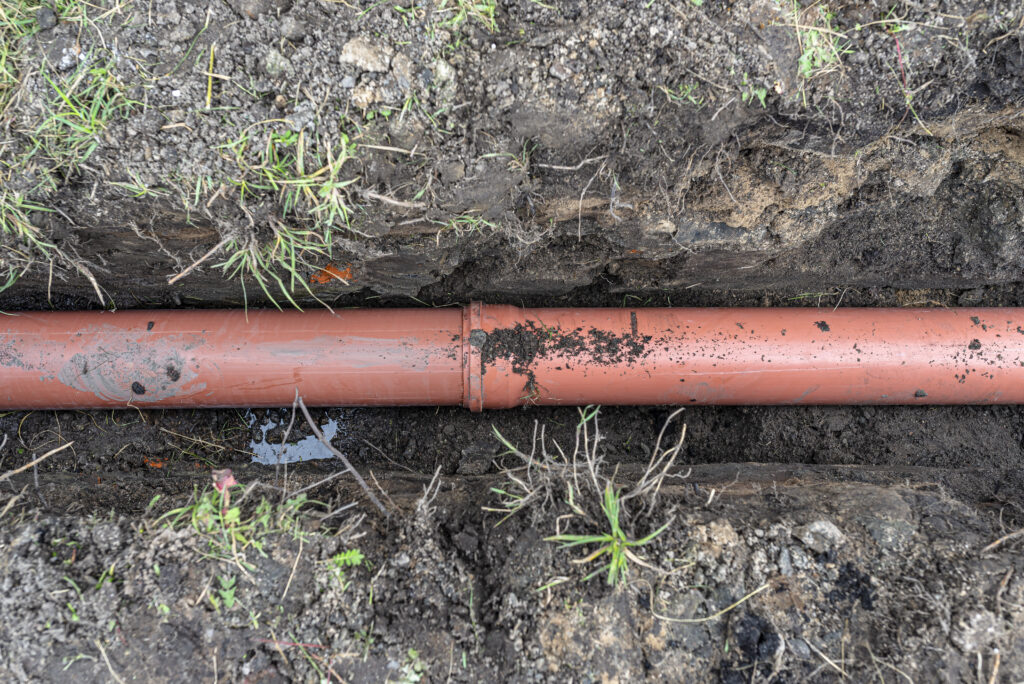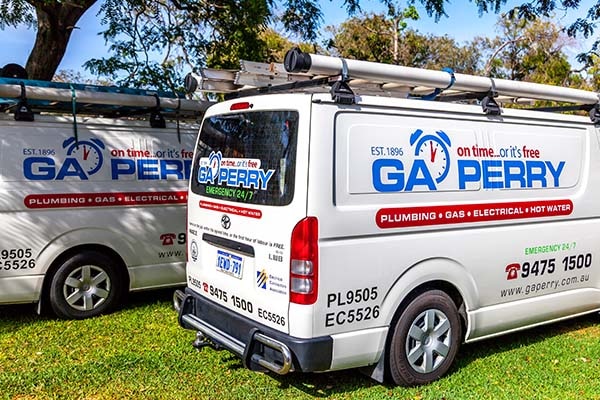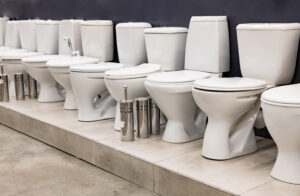Are you dealing with stubborn blocked drains that just won’t budge? A plunger or drain snake might help with surface clogs, but when the problem runs deeper in your pipes, DIY solutions can only go so far. And the last thing anyone wants is a messy excavation just to get the water flowing again!
Hydro-jet drain cleaning is an advanced plumbing technique that uses pressurised water (up to 60,000 PSI) delivered through specialised nozzles to blast away the most persistent blockages like built-up grease and sludge to invasive tree roots, without relying on harsh chemicals.
At GA PERRY, we’ve seen why hydro-jetting has become such a popular drain cleaning solution. It’s eco-friendly, non-invasive, and effective at tackling even the toughest clogs. But before you rush to book a service, it’s important to know whether this advanced method is the right fit for your situation.
- Hydro-jet drain cleaning removes tough blockages completely by flushing grease, hair, sludge, mineral deposits, and tree roots from the entire pipe diameter.
- The method is safe, eco-friendly, and non-invasive, using high-pressure water instead of harsh chemicals to protect pipes and the environment.
- Hydro-jetting is ideal for severe or recurring clogs where traditional methods fail, commercial kitchens, large households, and pre-relining pipe prep
- Professional expertise is essential, as trained plumbers adjust water pressure and nozzle type to safely clean pipes without causing damage.
- Prevent future blockages with proper maintenance by using strainers, disposing of grease and food correctly, monitoring warning signs, and scheduling routine inspections.
What Is Hydro-Jet Drain Cleaning?
Hydro-jet drain cleaning is a modern plumbing solution that uses high-pressure water to blast away stubborn clogs and thoroughly clean the inside of your pipes. Unlike traditional methods that only punch a small hole through the blockage or require excavation to remove blocked pipes, hydro-jetting clears the entire pipe diameter, removing grease, debris, mineral deposits, and even invasive tree roots.
Hydro-jetting gets its power from impressive water pressure. Standard equipment delivers between 2,000 to 6,000 PSI, strong enough to remove stubborn buildup without damaging most plumbing systems. Some specialised machines can even reach up to 35,000 PSI, making them effective for the toughest blockages.
Many systems can also switch between hot and cold water, ideal for dissolving grease, fat, and soap scum that melt under heat.
Key Components of a Hydro-Jet System
- Nozzle: Different types are designed for specific applications. For example, chisel nozzles cut through hardened clogs, ice, or tree roots.
- High-Pressure Hose: Flexible enough to move through bends and tight spots in pipes.
- Pressure Unit: A powerful machine (usually gas, diesel, or electric-powered) that pressurises the water. These units are often mounted on trailers for easy transport to job sites.
How It Compares to Other Methods
Hydro-Jetting vs. Snaking
Drain snaking (or augering) is one of the oldest and most widely used methods of unclogging drains. A metal coil or cable is fed into the pipe to break through the blockage. While it can be effective for minor clogs, snaking typically only creates a small opening through the obstruction, leaving much of the buildup still clinging to the pipe walls.
By contrast, hydro-jetting flushes the entire diameter of the pipe, washing away grease, soap scum, sludge, and mineral deposits. This not only removes the blockage but also prevents it from quickly reforming. Think of it as the difference between poking a hole in a dirty straw and giving the straw a complete rinse.
Hydro-Jetting vs. Chemical Cleaners
Chemical drain cleaners may seem like a quick fix, but they come with serious downsides. Harsh chemicals can corrode your pipes, especially older metal systems, and they often fail to remove the blockage completely. Over time, that means more clogs and potentially expensive plumbing damage.
They’re also harmful to the environment, as the chemicals wash into sewer systems and waterways. Hydro-jetting, on the other hand, uses only water under pressure, making it a safer, eco-friendly choice that cleans thoroughly without damaging your pipes.
Hydro-Jetting vs. DIY Solutions
Plungers and store-bought drain products can help with small, shallow blockages, like a minor clog in the bathroom sink. However, they can’t reach deeper issues in sewer lines or deal with tough obstructions like tree roots, grease buildup, or compacted debris.

How Hydro-Jetting Works
1. Inspection with CCTV Cameras
Before any cleaning begins, plumbers use specialised waterproof CCTV cameras to examine your drains. These cameras, attached to flexible cables, travel through your pipes and send live video footage to a monitor above ground. This lets technicians:
- Pinpoint the exact location of blockages
- Spot hidden issues like cracks, tree roots, or structural damage
- Assess the overall condition of your pipes without digging
2. Determining the Correct Water Pressure
Once the inspection is complete, plumbers calculate the right water pressure for your system. Professional hydro-jetting machines deliver 2,000–6,000 PSI, but the exact pressure depends on factors such as:
- Pipe diameter, material, and age
- Overall condition of the plumbing system
- Type and severity of the blockage
- Length of the pipe and access points
Experienced plumbers adjust the settings throughout the process to clear clogs effectively without damaging your pipes.
3. Hydro-Jetting in Action
With everything prepared, it’s time for the real work. A specialised nozzle is inserted into your drain, and high-pressure water streams through the pipes. Different nozzles are used depending on the problem, such as root-cutting nozzles for invasive tree roots or wider-spray nozzles for greasy buildup.
The high-pressure water doesn’t just break up blockages; it also scrubs pipe walls clean, washing away sludge, grease, and debris. Many hoses that can reach up to 60 metres, hydro-jetting clears even deep, hard-to-reach clogs without the need for excavation.
4. Post-Cleaning Inspection and Maintenance Checks
Once the job is complete, technicians run another camera inspection to confirm everything is clear. This final check ensures:
- Normal water flow has been restored
- All blockages have been completely removed
- Pipes are structurally sound and free from hidden issues
Many plumbers also provide a record of your pipe’s condition, which helps plan for future maintenance and reduces the risk of repeat blockages.
Common Causes of Blocked Drains Hydro-Jetting Can Fix
Drain blockages can happen in any home, and understanding why they occur is key to choosing the right solution. Hydro-jet drain cleaning is a powerful method that tackles even the toughest clogs that traditional approaches often can’t handle. Here are the most common culprits:
- Built-Up Grease and Food Waste in Kitchen Drains: Kitchen sink clogs often start with cooking oils, fats, and food particles sticking to pipe walls. As these substances cool, they harden, narrowing the water flow path and creating a sticky surface that traps additional debris. Snakes or chemical cleaners may provide temporary relief, but they stillleave residue behind. Hydro-jetting removes years of grease buildup, restoring your pipes to near-new condition.
- Hair, Soap Scum, and Residue in Bathroom Pipes: Bathroom drains frequently suffer from hair and soap scum blockages. Hair tangles with debris, while soap leaves a sticky coating inside pipes, slowing drainage and causing backups. Hydro-jetting breaks apart these stubborn materials and flushes away all residue, leaving pipes thoroughly clean and free-flowing.
- Tree Root Intrusion in Outdoor Plumbing: Tree roots can infiltrate outdoor plumbing through tiny cracks or loose joints, seeking water and nutrients. Once inside, they grow rapidly, creating major blockages and potential structural damage. Hydro-jetting uses specialised root-cutting nozzles to blast through root masses and flush debris, preventing roots from taking hold again.
- Mineral Deposits and Scale Buildup in Older Pipes: Hard water can leave behind calcium and magnesium deposits, especially in homes without water softeners. Over time, this scale reduces pipe diameter, restricting flow and increasing clog risks. Hydro-jetting shatters these mineral deposits and flushes them out, restoring full pipe capacity where other methods often fail.
- General Sludge and Debris Accumulation: Daily use of your plumbing system inevitably leads to layers of sludge and debris, which trap bacteria and reduces water flow. Hydro-jetting cleans the entire pipe wall, removing accumulated grime and preventing future blockages. This comprehensive cleaning provides a longer-lasting solution than traditional snaking or chemical treatments.

When Hydro-Jetting Is the Best Option
Hydro-jetting is a powerful plumbing solution, but it’s not needed for every clog. Here’s when it’s the right choice:
- Severe or Recurring Blockages: If your drains repeatedly back up despite plunging or snaking, there’s likely a deeper problem. Hydro-jetting excels at clearing stubborn blockages like mineral deposits, grease buildup, and invasive tree roots that standard methods simply can’t handle.
- Commercial Kitchens and Food Businesses: Oils, fats, and grease flow into pipes daily, creating thick buildups that snaking cannot break through. Regular hydro-jetting, typically once or twice a year, keeps commercial kitchen drains running smoothly, prevents costly blockages, and maintains compliance with hygiene standards.
- Large Properties or High Water Usage Homes: Big homes with complex plumbing or high water demand are prone to frequent blockages. Older homes with stainless steel or galvanised pipes, which accumulate mineral deposits more quickly, benefit particularly from high-pressure drain cleaning.
- Before Pipe Relining or Major Repairs: Hydro-jetting is often the first step before pipe relining. Cleaning pipes thoroughly ensures liner materials adhere properly, reducing the risk of relining failures. It also allows plumbers to take accurate measurements for resin application, improving long-term results.
When Hydro-Jetting May Not Be Suitable
- Fragile or Old Pipes: Pipes in older homes may have weak spots that cannot handle high water pressure. Materials like cast iron or clay are particularly vulnerable. Even normal hydro-jetting pressure can worsen small weaknesses, turning a routine service into a more costly emergency repair if pipes fail.
- Misaligned or Collapsed Drains: Pipes with structural issues. such as loose joints, rust, or previous repairs, can break under hydro-jetting pressure. If drains are collapsed or misaligned, alternative cleaning methods are safer. Full replacement may be necessary when pipes are extensively damaged.
- Not a DIY-Friendly Solution: Hydro-jetting requires professional training and certified plumbers. Improper use can damage pipes or cause serious injury and damage. Untrained individuals often use the wrong pressure settings, turning small clogs into costly disasters.
Preventing Future Blocked Drains After Hydro-Jetting
Hydro-jetting gives your pipes a fresh start, but taking a few simple steps afterward can help keep your drains clear for the long term.
1. Proper Disposal of Grease, Oils, and Food Scraps
Even when hot, cooking oils and grease will harden in your pipes, forming stubborn blockages. Instead:
- Pour used oils into a container for disposal in the trash.
- Compost food scraps or use council-provided FOGO collections that combine food and garden waste.
- A weekly boiling water flush can help dissolve small buildups before they become a problem.
2. Using Strainers in Sinks, Showers, and Bathtubs
Drain strainers are an inexpensive yet highly effective way to catch debris like hair, soap scum and food particles ,before it enters your plumbing system. Strainers come in mesh or perforated metal designs that fit directly into drain openings. Clean them regularly to ensure they continue protecting your pipes.
3. Routine Professional Drain Maintenance
Even after hydro-jetting, your pipes aren’t invincible. Regular professional inspections catch hidden blockages and early signs of damage before they turn into costly emergencies. With routine maintenance, you can protect your plumbing, prevent major disruptions, and extend the life of your pipes. We recommend inspections every 2–3 years to stay ahead of problems.
4. Watch for Early Warning Signs
Knowing the warning signs of drain issues lets you take action before a small problem turns into a costly emergency. Watch out for:
- Slow-draining sinks, showers, or bathtubs
- Foul or unusual odours from drains
- Gurgling noises after flushing
- Water backing up between fixtures
- Toilet bowls with unusually low water levels
Acting quickly on these symptoms can save your pipes, reduce the need for repeated hydro-jetting, and prevent expensive emergency repairs.
The High-Pressure Solution for Lasting Pipe Health
Hydro-jet drain cleaning is a highly effective, eco-friendly solution for tackling stubborn drain blockages that traditional methods can’t fully resolve. By thoroughly scouring your pipes, it removes grease, hair, tree roots, and mineral deposits, delivering longer-lasting results and reducing future plumbing issues.
While not suitable for every pipe, particularly older or fragile systems, hydro-jetting offers a complete, professional approach to keeping modern plumbing in top condition. Combined with proper daily habits, regular inspections, and expert guidance from qualified plumbers, this advanced method helps ensure your drains stay clear, your plumbing lasts longer, and emergency blockages become a thing of the past.
Don’t let stubborn blockages disrupt your home or business. Our team of qualified plumbers at GA PERRY has the tools and expertise to restore your pipes to peak performance. We tackle everything from minor clogs to serious backups, providing fast, reliable, and eco-friendly solutions, including professional hydro-jet drain cleaning and routine maintenance.



